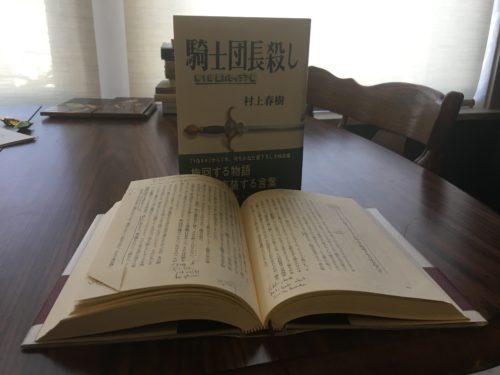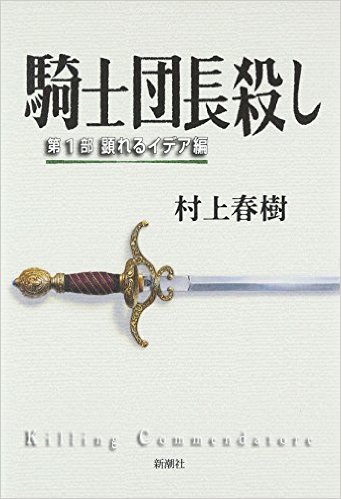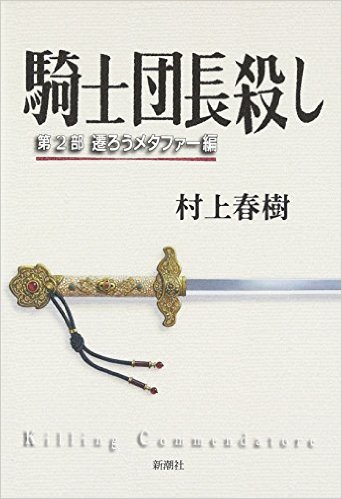
My review of the new Murakami novel Killing Commendatore (騎士団長殺し) is in the Japan Times this week: “‘Killing Commendatore’: Murakami’s latest lacks inspired touch of earlier works”
In short, it was not very good. I’ll be very curious to see how it turns out in translation and what the reviews are like. I haven’t seen any announcement of a translator or translation date so far.
The word count of the review prevented me from going into detail, partially because I couldn’t use many quotes and partially because it took so many words to summarize (about 550 of roughly 1000 words). I realize this could be my failing as a writer (although I’m pretty happy with my summary, notably with the absence of spoilers), but the book itself also eludes summary: once you start summarizing, you realize that you’re starting to give away the secrets of the book. Because so very little happens, summarizing any of the reveals gives away bit by bit some of the only development/pleasure of reading the book.
And there are so many secrets being kept in this book. Secrets between the narrator and Menshiki. Secrets between the narrator and Marie. As in 1Q84 (and other books?!), there are several points where the characters actively conspire to avoid involving the police—“They’d never believe us! And it could get troublesome for us.” At one point, the narrator allows an old man to go through what appears to be a tremendous amount of pain without calling for help at an old folks home while he has a conversation about how to proceed with solving the disappearance.
The pacing of the book also feels off. The first half is the narrator finding the painting, digging up the hole, and getting to know Menshiki and his mysteries, padded with some background story about himself and his family, which I was not able to address in the review. The second half, rather than beginning to unwind some of the build-up, goes on to introduce new characters and build up more mysteries before a disappearance in Chapter 45 (of 64) and the start of the true “adventure” in Chapter 53. I think the first half of the novel could have been much shorter than it was.
It’s difficult to express exactly how artlessly Murakami incorporates the historical information in this book. He uses his favorite device of having a character go research something at the freaking library, which he’s been doing since Hard-boiled Wonderland and the End of the World at least, although perhaps even as far back as A Wild Sheep Chase? I can’t remember.
On several other occasions, a character says something like “oh, by the way, I found out X” and then proceeds to drop fat blocks of dialogue that have no relation to the rest of their conversation or other plot development.
And Murakami takes the strange step of including a lengthy quote from Samuel Willenberg, survivor of the Treblinka extermination camp, as the entirety of Chapter 32, the final chapter in Book 1. (Which I guess suggests that the narrator chose the quote and decided to include it in his telling of the story?)
The goal seems to be to make a statement about art—the quote, which I believe is from a documentary but have not been able to track down/confirm, suggests that art can change/influence people, which doesn’t exactly jive with the novel. I’m not sure what it is that Murakami wants the reader to understand about art from reading this book.
The retrospective point of narration is equally lazy. This plays a part most noticeably in the first few chapters when the narrator feels very under control of how information is being presented. But it fades away quickly, leaving only vestigial, chapter-ending, retrospective paragraphs that help build some suspense going into the subsequent chapter, but even these fall away as the book progresses! The whole point of telling a story retrospectively is so you don’t have to do a blow by blow other than for the most dramatic incidents, but stream of conscious narration seems to be what Murakami is best at writing or considers most meaningful. He’s obsessed with his characters’ process of living/working, and he details those processes in nearly every book he writes.
I don’t know, maybe I’m wrong. Jay Rubin has written in his book on language about how easy it is for students of Japanese to mistake the pleasure of being able to read/understand Japanese for the literature itself actually being good. I don’t think I’m making that mistake here, as it was not fun to devote 23 days of my life to doing nothing but reading this book, but I do think that it can be difficult to grasp the whole of a work I’ve read in Japanese.
This is why I took loads of notes in the margins. This is why I wrote 28,668 words of chapter summaries. (NOTE: Write the summary immediately after you finish reading the chapter so that it’s a true summary and not just a write-up of your notes. I find it much easier to conceive of the chapter as a whole if I do it that way.) So I’m fairly confident in my evaluation. 1Q84 helped me notice many weaknesses about Murakami’s work, but this one has thrown them into stark contrast. The play-by-play narration works if the narrator is interesting and funny, as in his early works, but here there are just so many unnecessary details that feel given purely for the sake of describing something or because that’s what would have happened.
In my writing workshops, one workshop leader always had participants imagine the work under consideration in its best form at the end of the workshop. I think Killing Commendatore in its best form is a book that makes some kind of statement about art, what it does to viewers, how one makes it, why one makes it, what it means to devote your life to art, and how that can affect artists.
This seems to be what Murakami tries to do with his opening prologue, which is actually very good. The narrator awakes from a nap, and a man without a face is sitting across from him. He’s been here before, and he’s back because the narrator has been unable to draw his portrait. The narrator struggles and again fails. The man disappears with a puff of smoke, promising to return. It feels like this is a good metaphor for a tortured artist trying forever and ever to achieve some intangible, unobtainable goal with their art.
If only that had anything to do with the rest of the book! There are bits and pieces here and there that readers might be able to use to come to some sort of conclusion along those lines, but Murakami is asking readers to do a lot of the work for him.
At any rate, it feels good to have it under my belt, and I’m glad to have had another 1,048 pages of language practice. I read an average of 45.6 pages/day, which is 10 below my pace for 1Q84. This is a little surprising. I wonder if I’ve lost focus, have more going on these days, or if the book was just bad.
やれやれ. (Only one instance of this word in the entire book!) I hope that you all enjoyed following along here, on Facebook, or on Twitter. Until next time! (Which I guess will be in 2024 or 2025 if we’re going by long books or 2021 if we’re going by short books.)


